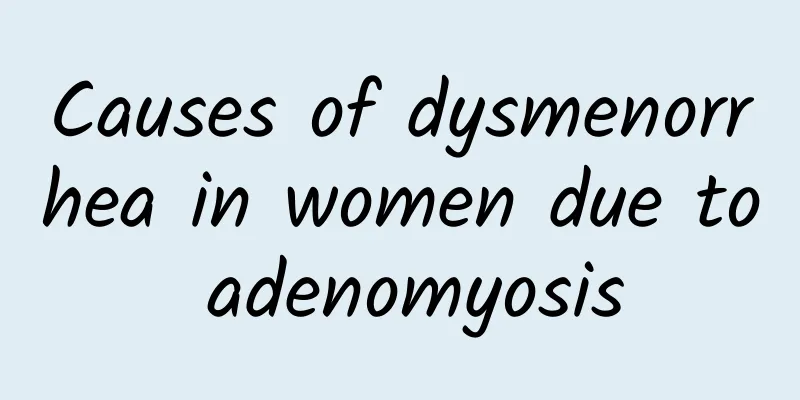Causes of dysmenorrhea in women due to adenomyosis

|
As we all know, dysmenorrhea is one of the common symptoms of women's menstrual period. The pain that goes deep into the bone marrow must be deeply understood by every woman who has experienced dysmenorrhea. It is understood that dysmenorrhea can also be divided into primary and secondary types. Methods/Steps Among them, primary dysmenorrhea refers to the dysmenorrhea that occurs with the first menstruation during the female development period. This phenomenon tends to gradually improve as the female sexual development gradually matures. Secondary dysmenorrhea refers to the dysmenorrhea that occurs after the female reproductive system has lesions. Because the pain is generally deep and has a great impact on women's daily life, it has become the "most unbearable" pain in women's lives. Female dysmenorrhea caused by adenomyosis is one of the representatives! One of the main causes of adenomyosis is damage to the uterine wall caused by multiple pregnancies and childbirths in women. Since there is no submucosal layer between the basal layer and the myometrium of the endometrium, under normal circumstances, the basal layer endometrium does not invade the myometrium downward. When the endometrium invades the myometrium, it will lead to the occurrence of adenomyosis. The treatment recommended is to take Fuyan Pills. Because the ectopic endometrium grows diffusely or locally in the myometrium, it stimulates the proliferation of the surrounding smooth muscle and fibrous connective tissue, interfering with the normal contraction of the uterus. Especially before or during menstruation, congestion, edema or bleeding causes the uterus to be larger than usual. Due to the stimulation of increased local pressure, the surrounding muscles undergo spasmodic contraction and cause dysmenorrhea. Causes of dysmenorrhea in women due to adenomyosis Patients with adenomyosis also have uterine hypoplasia, which causes abnormal blood supply, leading to uterine ischemia and hypoxia, causing dysmenorrhea. The narrowing of the cervical canal caused by adenomyosis hinders the outflow of menstruation, thus causing dysmenorrhea. The content of prostaglandins in menstrual blood and endometrium increases, causing the uterine muscle fibers to contract and causing dysmenorrhea. Dysmenorrhea is caused by excessive contraction of the uterus. As the uterus contracts violently, the uterus cannot completely relax for a long period of time, thus causing dysmenorrhea. Precautions Dysmenorrhea is a serious symptom of adenomyosis in women, which is very harmful to modern women. From the perspective of traditional Chinese medicine, adenomyosis belongs to the category of symptom. With the acceleration of the pace of modern life, adenomyosis is showing a trend of younger people, and many young unmarried women have also become victims of this disease. If you want to treat the root cause, you should treat it from the perspective of clearing away heat and detoxification, and promoting blood circulation and removing blood stasis. |
<<: Can irregular menstruation cause leg pain?
>>: Do you know about the related issues of vaginitis infection?
Recommend
What should you pay attention to after a missed abortion? Do these 5 things
Abortion is a physical and psychological injury t...
Are female stars crazy about drinking lemon water to lose weight? Burn fat with vitamin C
Lemon water weight loss is quite popular among fe...
What harm will painless abortion bring to women?
With the development of today's society, abor...
How to tell if you have chronic pelvic inflammatory disease
How to determine whether you have chronic pelvic ...
What are the test indicators for adenomyosis?
What are the examination indicators for adenomyos...
What are the common symptoms of ovarian cysts?
What are the symptoms of ovarian cysts? Ovarian c...
What can you eat to make uterine fibroids smaller? Eat 4 more foods to eliminate uterine fibroids
What can you eat to make uterine fibroids smaller...
What medicine is good for women with irregular menstruation? Traditional Chinese medicine symptomatic treatment of irregular menstruation
Menstrual irregularities occur from time to time ...
How to avoid recurrent miscarriage in early pregnancy
How to avoid recurrent miscarriage in early pregn...
Does pelvic inflammatory disease cause blood in urine?
Pelvic inflammatory disease is a common gynecolog...
Different types of female vaginitis symptoms lead to different characteristics of leucorrhea
Different conditions can cause different symptoms...
Can I eat wolfberry if I have adenomyosis? Yes.
Patients with adenomyosis can eat wolfberry. Aden...
What to do if you have cervical precancerous lesions in late pregnancy
I believe that for every female friend, nurturing...
Pay attention to the precautions after painless abortion
Nowadays, many female friends have experienced un...
Why does vaginal candidiasis recur?
Why does candidal vaginitis recur? The recurrence...









